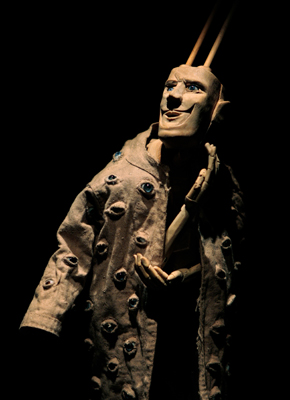The Huntington’s blog takes you behind the scenes for a scholarly view of the collections.
EXHIBITIONS | The Eyes of John Frame
Posted on Mon., May 2, 2011 by
The haunting, soulful tone that underscores the John Frame exhibition "Three Fragments of a Lost Tale: Sculpture and Story by John Frame" is set in large part by the characters' eyes. Certainly the dark lighting has dramatic effect, and the sweep of soft violin and piano in the distant background provides a sense of melancholy. But it is the facial expressiveness of the 35 characters Frame has created that arguably makes the exhibition work on a deeply emotional level. And that expressiveness is centered in the eyes.
Frame's exhibition is a tour de force, the culmination of six years of working in isolation to create a cast of characters composed primarily of wood and found objects.
The most difficult part of the project, he says, was in carving the faces—in getting them right—and ensuring that the little glass eyes he used were properly selected and paired to achieve each character's unique expression.
A sophisticated user of eBay, Frame purchased hundreds of dolls' eyes from collectors of vintage dolls fabricated in mid-19th-century Germany. The area of Thurlingia was a center for doll manufacturing until World War I put a dent in production and World War II put an end to it entirely. Most of the factories were either repurposed or destroyed, but until that time, manufacturers produced a multitude of dolls and doll parts. The eyes, typically blue, were hand blown. Seconds—the ones with flaws—were tossed in landfills nearby, and in recent years, collectors have been excavating them. Enter eBay. Frame says he was particularly interested in the peculiar nature of these particular objects. "They were damaged parts. The eyes all had defects—irises that were misshaped or pupils that were too bulbous," he says. "And these flaws were precisely what appealed to me."
Ultimately, Frame bought hundreds of dolls' eyes to have enough to make proper pairings. None came in pairs, so it was up to him to make them work together. Or not. The character who has perhaps the most intriguing eyes, to Frame, is Argus. His eyes evoke the sense that they operate independently, somewhat like a chameleon's. Worth noting is that his cloak, composed of 100 eyes, actually "winks" in the stop-motion animated film.
Frame talks about the unique power of the human eye in a companion film in the exhibition that explores the artist's process: "It is the immense subtlety of the human eye that allows us to understand what the subject matter of art really is. That ability to recognize a face among the billions of faces on the planet is the same exact visual skill that we use to understand art."
Go see for yourself.
Susan Turner-Lowe is vice president for communications at The Huntington.
